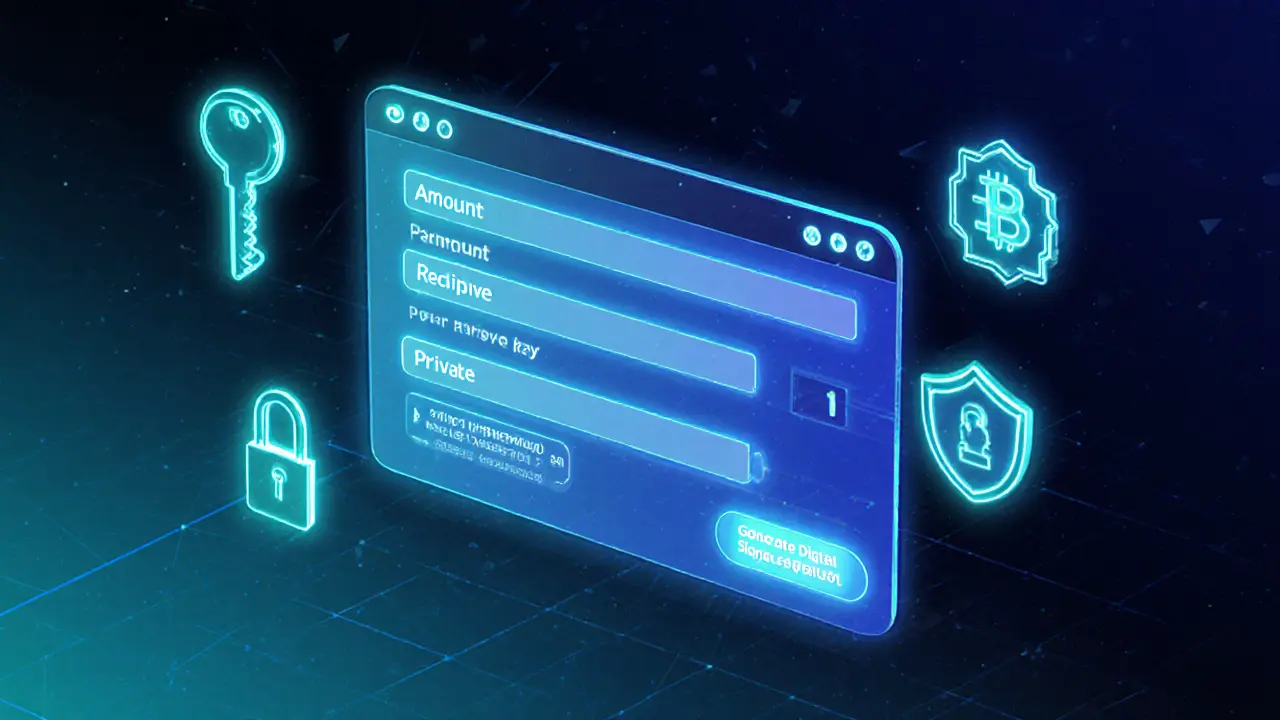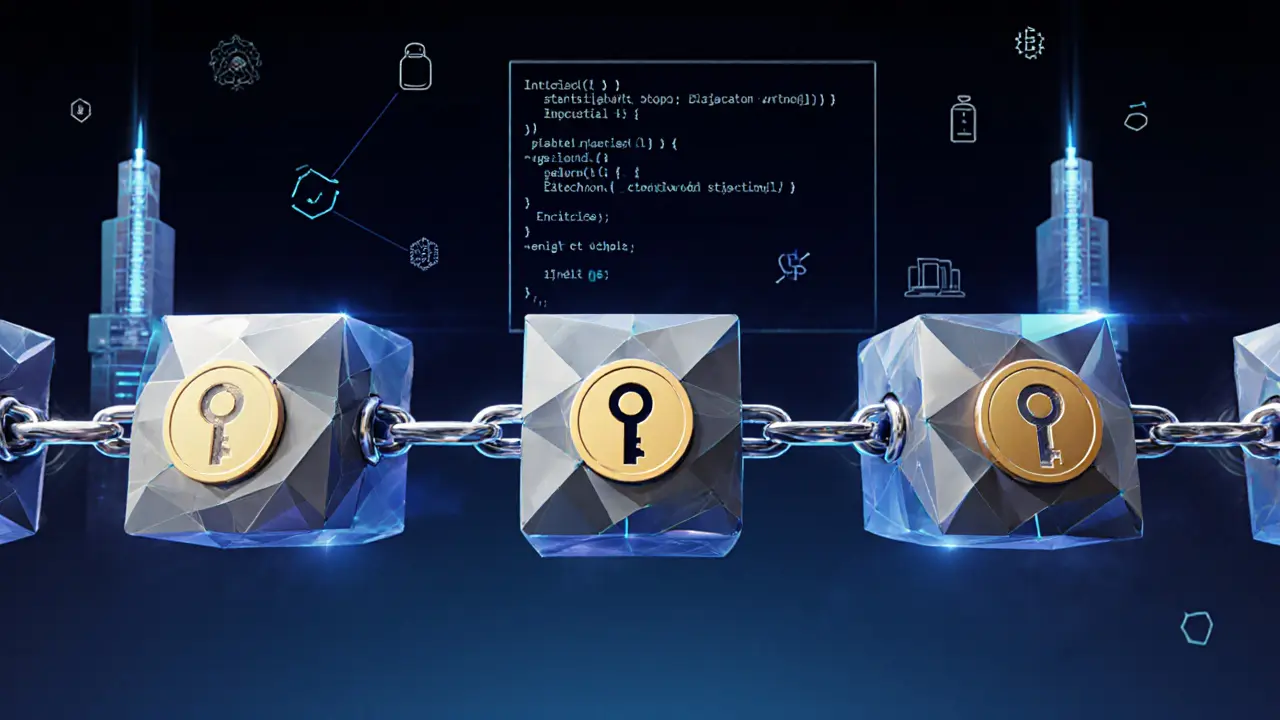How Digital Signatures Secure Blockchain Transactions
 Jan, 16 2025
Jan, 16 2025
Digital Signature Security Checker
Security Analysis Result:
Key Takeaways
- Digital signatures bind a transaction to its owner using asymmetric cryptography.
- ECDSA provides strong security with tiny keys, keeping blocks lightweight.
- Authentication, integrity, and non‑repudiation are the three security guarantees.
- Every node can verify a signature without ever seeing the private key.
- Smart contracts rely on signatures to enforce trust‑less agreements.
When you hear people talk about digital signatures in the blockchain world, they’re really talking about the secret sauce that stops fraudsters from stealing or altering your crypto. Let’s break down why this cryptographic trick makes blockchain transactions feel bullet‑proof.
Digital signatures are cryptographic codes that verify who created a digital message and that the message hasn’t been changed work on a simple idea: a private key creates a unique code, and a matching public key proves the code is genuine. In a blockchain, that code travels with every transaction, and every node in the network checks it before accepting the data.
Blockchain is a distributed ledger that records transactions in immutable blocks became famous because it can run without a central authority. But without a way to prove who’s allowed to write to that ledger, the system would be open to chaos. That’s where digital signatures step in.
How Asymmetric Cryptography Powers the Ledger
Every participant gets a public key a cryptographic string that anyone can see and use to verify signatures and a matching private key a secret string that only the owner knows and uses to create signatures. When you want to send funds, your wallet takes the transaction data, runs it through a hashing function, then mixes in the private key using a signing algorithm. The result is the digital signature that travels with the transaction.
The ECDSA Advantage
Elliptic Curve Digital Signature Algorithm (ECDSA) is the signature scheme used by Bitcoin, Ethereum and many other blockchains is the workhorse behind most crypto‑transactions. Compared to older schemes like RSA, ECDSA delivers the same security level with keys that are roughly 10‑15 times smaller. Smaller keys mean shorter signatures, lower bandwidth usage, and faster verification-critical factors when millions of nodes are checking every block.
Three Security Pillars
Digital signatures give blockchain three core guarantees:
- Authentication: The signature proves the transaction was created by the holder of the corresponding private key.
- Integrity: Because the signature is generated from a hash of the exact transaction data, any change in the data breaks the signature.
- Non‑repudiation: Once a signature is on the chain, the signer cannot later deny having authorized the transaction.
Verification in Action
Imagine Alice wants to send Bob 1BTC. She creates a transaction, signs it with her private key, and broadcasts it. The moment the transaction reaches the network, every miner a node that validates transactions and assembles them into blocks (or validator in proof‑of‑stake systems) pulls Alice’s public key from the transaction, runs the verification algorithm, and checks that the signature matches the hash of the transaction data. If the check passes, the transaction is eligible for inclusion in the next block; if it fails, the network discards it.

Immutability - The Signature as a Tamper‑Proof Seal
Once a signed transaction lands in a confirmed block, the block’s hash links it to the previous block, creating an immutable chain. If anyone tries to edit the transaction, the original signature no longer matches the new hash, instantly flagging the tampering. This built‑in tamper evidence is why blockchains are trusted for record‑keeping: you can’t rewrite history without breaking the cryptographic math.
Smart Contracts Need Signatures Too
Beyond moving coins, smart contracts are self‑executing code that runs when predefined conditions are met also rely on signatures. Parties sign the contract’s deployment transaction, and later each interaction (e.g., calling a function) is signed by the caller. The contract checks the caller’s signature against the stored public key before executing any state change. This eliminates the need for a trusted third party and locks in the agreement with the same cryptographic guarantees used for simple payments.
Why Not Just Use RSA?
Older systems like RSA require keys of 2048bits or more to achieve security comparable to a 256‑bit ECDSA key. Larger keys increase transaction size, slow down verification, and raise storage costs. Blockchains are designed to be lightweight and fast, so the industry converged on ECDSA (and newer schemes like EdDSA) to keep the network efficient.
| Algorithm | Typical Key Size | Signature Size | Verification Speed | Adoption |
|---|---|---|---|---|
| RSA | 2048‑4096bits | 256‑512bytes | Slow (large exponentiation) | Rare in modern blockchains |
| ECDSA | 256bits (secp256k1) | 64‑72bytes | Fast (elliptic‑curve operations) | Bitcoin, Ethereum, many others |
| EdDSA (Ed25519) | 256bits | 64bytes | Very fast (no per‑signature randomness) | Emerging in newer chains (e.g., Solana) |
Beyond Crypto: Real‑World Applications
Supply‑chain platforms embed a digital signature with each product batch record. When a supplier ships goods, they sign the batch metadata; downstream parties verify the signature before accepting the shipment. This creates an auditable trail that prevents counterfeit goods from entering the chain.
Identity solutions on blockchain let users prove ownership of a wallet without exposing the private key. A decentralized app can request a signed message (“I own address 0x…”) and verify it instantly, enabling KYC‑free login experiences.
Best Practices & Common Pitfalls
- Never share your private key. A leaked key lets an attacker forge signatures and steal assets.
- Use hardware wallets or secure enclaves to keep the private key isolated from the internet.
- Avoid reusing the same nonce (k‑value) in ECDSA signatures; doing so can expose the private key.
- Rotate keys for long‑term contracts and store backups in multiple safe locations.
Wrapping It Up
Digital signatures are the silent guardians of every blockchain transaction. By binding a unique cryptographic proof to each piece of data, they give us authentication, integrity, and non‑repudiation-all without a central authority. Whether you’re moving Bitcoin, triggering a smart contract, or tracking a product’s provenance, the signature is what makes the whole system trustworthy.

Frequently Asked Questions
What exactly does a digital signature prove?
It proves that the holder of a specific private key created the message and that the message has not been altered since it was signed.
Why do most blockchains use ECDSA instead of RSA?
ECDSA delivers comparable security with far smaller keys and signatures, reducing transaction size, bandwidth, and computational load-crucial for a network where every node validates every transaction.
Can a signature be forged if someone sees my public key?
No. The private key is required to generate a valid signature. The public key alone only allows verification, not creation.
What happens if a transaction’s signature is invalid?
Nodes reject the transaction outright, and it never gets included in a block. The sender must correct the error-usually a mismatched key or corrupted data.
Do smart contracts store signatures?
Smart contracts don’t keep the raw signature after verification, but they do store the corresponding public key or address to confirm future calls.
Is it safe to sign transactions on a mobile phone?
It can be, if the phone uses a secure element or a reputable wallet that isolates the private key. Otherwise, hardware wallets remain the safest choice.
How does a digital signature make a blockchain immutable?
Because the signature ties the exact transaction data to a cryptographic proof, any later edit would break the proof, causing verification to fail. Hence the record stays forever unchanged.


vipin kumar
January 16, 2025 AT 18:30When you dive into the world of digital signatures, you quickly realize that the whole thing is a massive trust exercise in a system that pretends to be trustless. Every transaction rides on the belief that a private key stays private, but who’s really guarding those keys? Look at the massive mining pools and centralized exchanges that cradle the majority of private keys – if any of those get compromised, the entire blockchain could be hijacked. The cryptographic math is solid, sure, but the implementation often hides backdoors, especially in proprietary wallet software that never gets audited. You also have to consider the quantum threat; while we’re still a few years away, the moment a quantum computer arrives, all those signatures could be ripped apart like cheap paper. It’s not just a theoretical risk – nation‑state actors are already stockpiling enough qubits to break current curves. Then there’s the nonce reuse problem in ECDSA, a classic mistake that even seasoned developers make, and it can leak the private key in seconds. Every time you sign a transaction you’re basically handing over a piece of your identity, and if that piece gets stained, you’re done. The idea that “every node can verify without the private key” sounds great until you factor in the fact that the public key itself can be used to trace activity across multiple chains. All of this makes you wonder whether the “decentralized” hype is just a clever marketing spin, shielding us from the realities of centralization in the background. So, while the math is bullet‑proof, the ecosystem around it is riddled with potential points of failure that the average user never sees. Use hardware wallets, keep backups offline, and stay skeptical of any service that asks for your private key. The moment you stop questioning the infrastructure is the moment you hand over control. In short, digital signatures are a powerful tool, but they are only as secure as the people and processes protecting those keys – and those are often the weakest link.
Mark Briggs
January 23, 2025 AT 23:43Great, another magic bullet, because that never fails.
mannu kumar rajpoot
January 31, 2025 AT 04:56Honestly, the whole discussion glosses over how easy it is to mess up the nonce in ECDSA – a single slip and your private key is out in the open. It’s not just about big players; even hobbyist developers can introduce fatal flaws with a careless implementation. While you’re busy praising cryptography, the real danger lurks in the everyday tools people actually use. Think about the countless wallet apps that never get a third‑party audit. That’s where the real risk lies, not in the elliptic curve math itself.
Vaishnavi Singh
February 7, 2025 AT 10:09From a philosophical standpoint, digital signatures illustrate the paradox of trust in a trustless network. They embody the idea that verification can occur without disclosure, yet they also remind us that true security is a social construct as much as a mathematical one.
Peter Johansson
February 14, 2025 AT 15:22Nice breakdown! 😊 If you’re just starting out, remember to keep your private keys offline and use a hardware wallet whenever possible. It’s the simplest step that adds massive security.
Cindy Hernandez
February 21, 2025 AT 20:36Great overview. For anyone looking to implement their own signing routine, be sure to use a well‑tested library like libsecp256k1 and always verify that the nonce is truly random. Skipping these steps can open up serious vulnerabilities.
Kyle Hidding
March 1, 2025 AT 01:49In the realm of cryptographic implementations, one must consider the entropy source for nonce generation, otherwise the deterministic nature of ECDSA could be exploited, leading to private key exposure. Moreover, the interface between the signing module and the ledger must be hardened against side‑channel attacks, which are often overlooked in high‑level documentation.
Andrea Tan
March 8, 2025 AT 07:02I love how clear this article makes the concepts. It’s refreshing to see an explanation that doesn’t drown you in jargon.
Donald Barrett
March 15, 2025 AT 12:15This whole "digital signatures are bullet‑proof" narrative is so naive. Everyone knows the real world isn’t that clean.
Christina Norberto
March 22, 2025 AT 17:28While the exposition is thorough, one must remain vigilant regarding the underlying assumptions of cryptographic primitives. The security of ECDSA is contingent upon the hardness of the discrete logarithm problem, and any deviation from established parameters could compromise the entire framework. Consequently, rigorous adherence to protocol specifications is indispensable.
Fiona Chow
March 29, 2025 AT 22:41Sure, the article is solid, but let’s not pretend the ecosystem isn’t riddled with half‑baked wallets that leak keys left and right. If you want real security, audit your tools, not just the theory. 🙄
Rebecca Stowe
April 6, 2025 AT 03:54Stay positive, folks! Even if there are risks, the community is constantly improving security standards, and educating ourselves is the best defense.
Aditya Raj Gontia
April 13, 2025 AT 09:07Honestly, the article could’ve cut the fluff and just said: use a reputable wallet, keep your seed offline, and don’t share your private key.
Kailey Shelton
April 20, 2025 AT 14:20Not bad, but I think the piece could’ve dived deeper into the practical steps for developers.
Angela Yeager
April 27, 2025 AT 19:33Good point, Kailey. Adding a checklist for secure implementation would definitely help newcomers avoid common pitfalls.
Tilly Fluf
May 5, 2025 AT 00:46Overall, the article presents a comprehensive view of digital signatures within blockchain technology, and it appropriately highlights both theoretical strengths and practical considerations for secure deployment.
kishan kumar
May 12, 2025 AT 05:59Excellent exposition! 😊 It’s crucial to remember that while signatures safeguard authenticity, the human factor remains the most unpredictable variable in any cryptographic system.
Anthony R
May 19, 2025 AT 11:12Bravo! The article covers the essential aspects of digital signatures – from the cryptographic foundations to practical implementation tips – ensuring readers gain a well‑rounded understanding.
Karl Livingston
May 26, 2025 AT 16:25Really enjoyed the deep dive; the comparison table was especially helpful. It’s nice to see the trade‑offs between RSA, ECDSA, and EdDSA laid out so clearly.
Gaurav Gautam
June 2, 2025 AT 21:38Glad you liked the table! I’d add that Ed25519’s deterministic signatures also reduce the risk of nonce‑reuse attacks, making it a solid choice for newer blockchains.
Robert Eliason
June 10, 2025 AT 02:51Meh, signatures are just another layer of complexity. Who needs all this when you can just trust a central authority?
Cody Harrington
June 17, 2025 AT 08:04I respectfully disagree – decentralization plus robust signatures provides a balance that centralized systems simply can’t achieve.
Chris Hayes
June 24, 2025 AT 13:17The article does a solid job, but it could have addressed the importance of key rotation in long‑term contracts to mitigate exposure risk.
victor white
July 1, 2025 AT 18:30While the exposition is commendable, one must also contemplate the sociopolitical implications of entrusting cryptographic primitives to entities that may harbor ulterior motives.